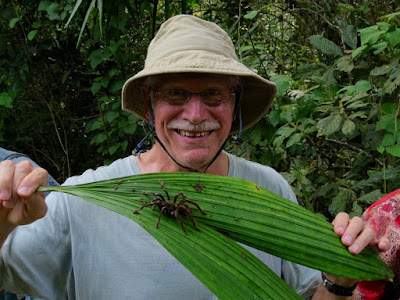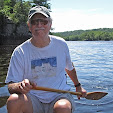Truth be told, I wasn’t drawn to this experience by either the people or the culture. And, while the sense of place—all those references in literature and film to the mysterious, perilous Amazon—certainly drew me in, what I really wanted to see was the wildlife.
The Amazon Rainforest is home to one in ten of all living species on earth—at last count 427 mammals, 1,294 birds, 428 amphibians, 378 reptiles, 2,200 fishes, 80,000 plants, and an astounding 2.5 million species of insects.* And those are only the ones researchers have found.
As we ply a jungle path in search of
critters, it’s like slogging through a
steam bath after a power outage.
PECKING ORDER
Before boasting of the puny sampling of those organisms I was privileged to see and photograph, a little context:
In this, the largest rainforest biosphere on earth, some incredibly powerful forces and their more-or-less predictable cycles animate all life. The river, consistently rising and falling some 30 to 40 feet each year, is like the region’s pulsing artery; the rainforest, its lungs.
A rainforest this size creates its own weather on a massive scale. The steamy exhalations of billions of plants, cooked out by the powerful equatorial sun, rise each day into the atmosphere. There they’re swirled and cooled, wringing out the moisture as rain. And so it goes, day in and day out.
The plant canopy here is more than just a matter of survival of the tallest. It’s a complex, multi-tiered system. Through both competition and cooperation, each layer is claimed by those plant and animal species which have evolved to do best there.
 |
| PHOTO: Kevin Cure via WikiMedia Commons |
Sunlight, plentiful for the big boys, is all but consumed by the time it reaches the ground. One perfectly sunny afternoon, as we ply a jungle path in search of critters, it’s like slogging through a steam bath after a power outage—I can’t take a decent picture without flash.
Our guides uncannily mimic the
creatures’ voices, hoping to draw
them closer.
SKIFFIN’ IT
 The river boat La Perla—our comfortable home for the week—tows two large, outboard-powered skiffs. Every day we cast off in them for excursions into the numerous tributaries and backwaters of the upper Amazon and the Marañon. They also take us to trail heads where we embark on hikes through the jungle. There, facilitated by incredibly skillful naturalist guides—two of them our own; others, local to the areas we visit—we’re introduced to a wide variety of living wonders.
The river boat La Perla—our comfortable home for the week—tows two large, outboard-powered skiffs. Every day we cast off in them for excursions into the numerous tributaries and backwaters of the upper Amazon and the Marañon. They also take us to trail heads where we embark on hikes through the jungle. There, facilitated by incredibly skillful naturalist guides—two of them our own; others, local to the areas we visit—we’re introduced to a wide variety of living wonders. |
| Rothschilds moth |
From the skiffs, our guides employ an impressive range of tools of their trade. Their incredibly sharp eyes scan the woods, air and water for telling movements or patterns. Then a quick glance through binoculars confirms or denies a hunch.
If a bird or perhaps a monkey is too far away for the rest of us to see, they uncannily mimic the creatures’ voices, hoping to draw them closer. At times, they even broadcast recorded calls through a microphone.
At the outset of our trip, we’d been given a list of several hundred species of birds we might spot during these excursions. With our guides’ help—in some cases actually borrowing a guest’s camera to take the shot she or he couldn’t manage to frame—we manage to see well over half of them, an impressive list for any birder.
 |
| Great kiskadee |
 |
| Yellow-headed caracara |
 |
| Hoatzin |
From the water we observe several types of monkey, sloths, caiman…and the revered Amazon river dolphin, or boto. We even fish for the oft-maligned red-bellied piranha.
 |
| Pygmy marmoset |
 |
| Three-toed sloth |
 |
| Amazon river dolphin - PHOTO: Allen Sheffield via WikiMedia Commons |
 |
| Red-bellied piranha |
We find breathtaking flowers and inch our way through giant, 6-foot-diameter lily pads which, with their turned-up edges and sturdy fretwork substructure, have been famously photographed supporting a small child.
 |
| Frangipani |
 |
| Coconut palm stem cluster |
 |
| Kapok bud and flower |
After calmly posing it for photos and
casually brushing it off, he looks it up
in his spider book and discovers it is
highly venomous.
ALL CREATURES GREAT AND SMALL
On our ground explorations, while we stick to the path with one guide, the other is constantly tromping off-trail through the jungle, searching for critters large and small. One minute, he presents us with a gorgeous, inch-long poison-dart frog. Ten minutes later, he’s pointing out an eight- or ten-foot palm-like tree he says “walks” across the jungle floor looking for one of the few precious pools of sunshine seeping through the canopy.
 |
| Poison dart frog |
 |
| Kapok (lupana) tree with unidentified blue insect |
Later, he emerges from the dark, dense foliage once again, this time obviously lugging something much bigger. It takes us a few seconds to make it out in the dim light; draped over his shoulders is a 12-foot boa constrictor as thick as my calf. On another occasion, a huge spider suddenly appears on a guide’s shirt. Later, after calmly posing it for photos and casually brushing it off, he looks it up in his spider book and tells us it is highly venomous.
 |
| Red-tailed boa constrictor |
 |
| Venomous? Looks like a huntsman spider to me – if so, not so much. |
One could come here to Amazonia a dozen times and still not see more than a small fraction of its natural wonders—I imagine even natives discover something new every day. I'm privileged to have been able to come here once in my lifetime, if for no other reason than to catch this glimpse of earth's "lungs" first-hand.
The experience only strengthens my resolve to resist, in whatever ways I can, the short-sighted, self-serving, reckless actions of the current U.S. government—especially its willfully-ignorant dismissal of the consensus among climate scientists that our current treatment of the environment is likely to prove catastrophic.
And the reality-star president? Don't get me going; he wouldn't know a tarantula if it bit him on the ass. And I wish one would.
* Wikipedia (https://en.wikipedia.org/wiki/Amazon_rainforest)









2 comments:
"The experience only strengthens my resolve to resist, in whatever ways I can, the short-sighted, self-serving, reckless actions of the current U.S. government—especially its willfully-ignorant dismissal of the consensus among climate scientists that our current treatment of the environment is likely to prove catastrophic. And the reality-star president? Don't get me going; he wouldn't know a tarantula if it bit him on the ass. And I wish one would."
Couldn't agree more Jeff... and thanks for a great blog!
Thanks, Gary. I guess we both know, though, that if that tarantula did bite the pretender pres. in the ass, he'd either swear it didn't happen...or take it as a sign that his anti-tarantula agenda is working big-time. ;-)
Post a Comment